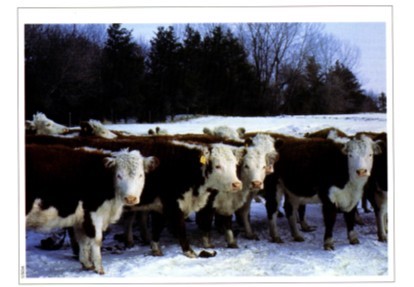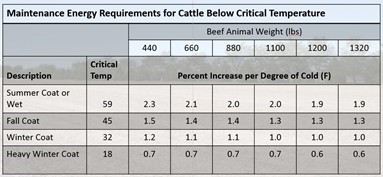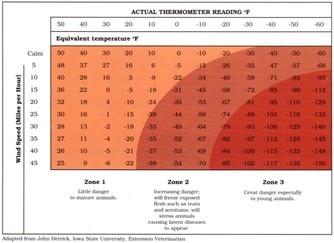AgEBB-MU CAFNR Extension
Green Horizons
Volume 22, Number 1
Winter 2018
Agroforestry
Cattle and Windbreaks - Protecting the Land, Protecting the Investment
By Pamela Bergstrom| Forester for the Lower Elkhorn Natural Resources District in Norfolk, NE and Online Agroforestry MS student at UMCA.
The beginning of 2018 has been frigid across much of the United States including the Great Plains and adjacent Midwest. Low temperatures have combined with high winds to produce deadly sub-zero wind chill readings. Millions of cattle are scattered across this region. Windbreaks are one excellent method to help protect livestock from extreme winter weather. Windbreaks consist of rows of trees are planted in straight rows around homesteads, cattle yards, and crop ground. During the Dustbowl in the 1930's, President Roosevelt (FDR) envisioned one massive windbreak from Texas Canadian border to prevent soil erosion and put people back to work through the Civilian Conservation Corps and Works Progress Administration.
It is well known that windbreaks improve crop yields (and crop quality) and help prevent wind borne soil erosion. In addition, depending upon their design, they can also provide numerous other benefits including: winter snow dispersal across crop fields to provide moisture to spring crops; road protection (i.e., living snow fences); protection for buildings and reduction in energy costs; enhancement of wildlife habitat; and reduction in odor plume around confined animal feeding operations (i.e., vegetative environmental buffers or VEBs). In addition to the multiple benefits of windbreaks already listed, this article will focus on the positive effects windbreaks have on cattle.
 |
Photo credit: Quam et al. Windbreaks for Livestock Operations. |
Cattle, especially beef cattle, are a major part of the economy in Nebraska and other Midwest states including Missouri, Iowa, Kansas, Oklahoma, Texas and the Dakotas. In the majority of these states, winters can be long and brutal, putting pressure on livestock health and reproduction, especially bred heifers or cows that calf during the late winter or early spring.
David Ames, retired environmental physiologist at Colorado State University, conducted studies at Kansas State University on cold weather effects on cattle. He developed wind chill indexes for cattle and established their critical temperatures. The value of windbreaks comes partly from understanding wind chill. Wind chill impacts, combined with energy requirements for cattle during cold weather, suggests there is a lot of value in feed cost savings, well-being of the animals, etc., if they are protected from wind when temperature drops below their thermo-neutral zone.
Livestock response to cold and wind chill.
Critical temperatures for beef cattle are determined in part by the condition of the coat. Below the seasonal critical temperatures, livestock must expend more energy to keep warm. For each degree (F) of cold, feed requirements are increased. At 10o F, cows need about 3.5-4 pounds of extra hay daily, or 2-2.5 pounds of grain. When temperatures drop to 10o F below zero, that figure can double, and cows will need 7-8 pounds of extra hay or 4-6 pounds of extra grain each day to maintain internal temperatures against the elements.
 |
Table 1. Critical temperatures for beef cattle are determined in part by coat condition. Below the critical temperature, livestock expend more energy in order to keep warm. Adapted from: Quam et al.Windbreaks for Livestock Operations |
Researchers at Purdue University found that energy requirements for cows in good condition increased 13% for each 10 degree drop in wind chill temperature below 30o F. A similar study in Iowa on calves and yearlings indicated that requirements for feed were 7% greater for those in open lots than for similar animals with shelter. Studies in Montana indicated that during mild winters, beef cattle sheltered by windbreaks gained an average of 34 to 35 pounds more than cattle in an open feedlot. During severe winters, cattle in feedlots protected from the wind, maintained 10.6 more pounds than cattle in unprotected lots.
Other types of livestock also benefit from shelter. Milk production in Holstein and Jersey dairy cattle declines at air temperatures below 35o F. The amount of decline is dependent on animal health, coat condition and feed intake. Under windy conditions further declines in production or increased feed requirements can be expected due to lower wind chill temperatures.
In total, the benefits of windbreaks on livestock include: reduced feed requirements; reduced livestock stress; reduced mortality; increased health; increased profits; and an improved working environment.
 |
Table 2. Animal wind chill chart. As temperatures decrease and wind speed increases the danger to animals becomes great. Source: Quam et al. Windbreaks for Livestock Operations. |
Currently in Nebraska and throughout large parts of the Midwest, windbreaks are under pressure from use of large equipment and center pivots. When many of the old windbreaks were designed and planted, center pivots had yet to be implemented and farm equipment was much smaller in stature. Today center pivots are common and farm equipment has grown from 6 row planters up to 48 row planters that need more horse power and, critically, more room to maneuver. Providing landowners with scientifically proven advantages of planting windbreaks in the form of protecting livestock during the harsh climates of the winter, will help to encourage and retention and restoration of windbreaks by farmers and ranchers.
Further Reading on Windbreaks
Quam et al. Windbreaks for Livestock Operations.
University of Nebraska Cooperative Extension Publication No. EC 94-1766-X. https://nfs.unl.edu/ documents/windbreaklivestock.pdf
USDA National Agroforestry Center. 1996. Outdoor Living Barns, Agroforestry Note #2, Windbreaks #2. https://www.fs.usda.gov/nac/ documents/agroforestrynotes/an02w02.pdf
